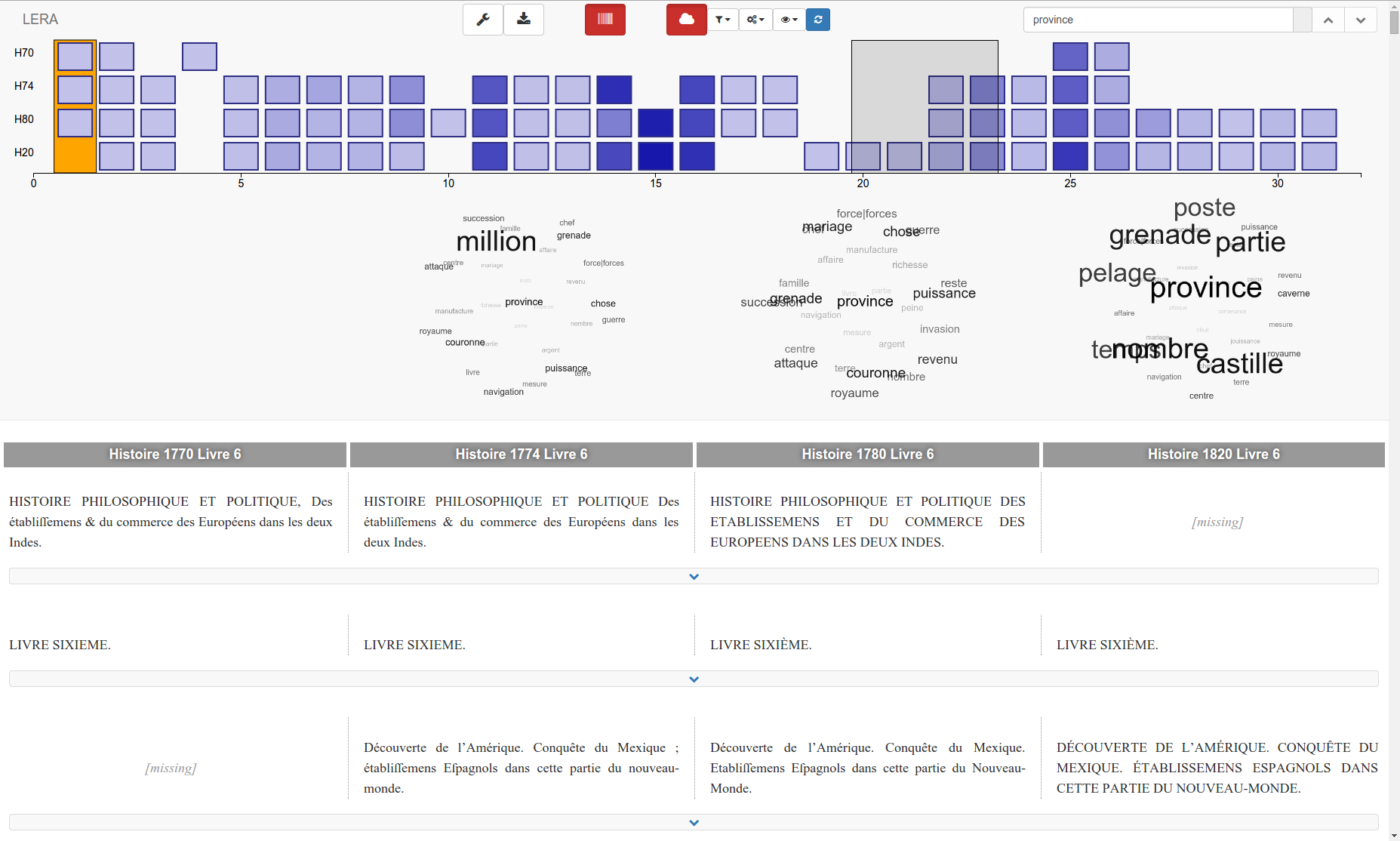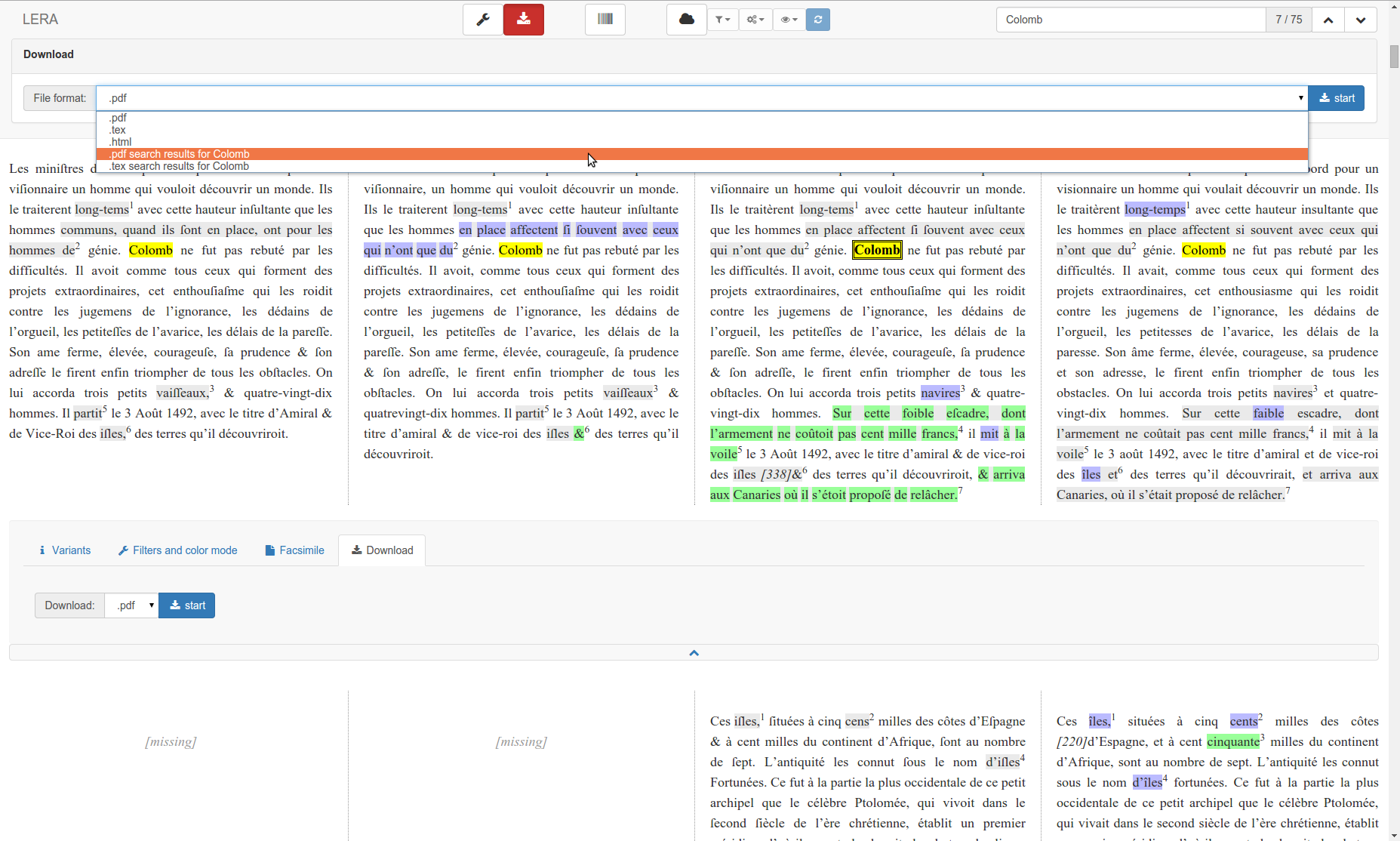LERA - Locate, Explore, Retrace and Apprehend complex text variants
|
LERA is an interactive, digital tool for inspecting similarities and differences between multiple versions of a text. To achieve this, LERA divides the texts into passages and displays them next to each other. Using colored highlighting, differences between versions can be located easily in a critical apparatus. LERA features a variety of tools for efficiently exploring differences between versions of texts: an interactive outline visualization (CATview), interactive word clouds and clever search functionality. This way, LERA supports the user retrace and finally apprehend the authors intentions. LERA has been developed for collating texts to provide a basis for historical critical editions. For a review from 2020, see RIDE Journal, Issue 11.
|
Institute of Computer Science
Martin Luther University Halle-Wittenberg

|
News: An update on the word clouds
The November 2022 update added the latest version of stable word clouds. These keep the positions of the words spatially stable even if the data basis changes. With the help of the linked and movable selection box in the CATview overview bar, it is thus easier to trace the development of the content of a work over its length and the different text witnesses.
Demo
Main features
Easy to read sidy-by-side comparison:
LERA generates a synoptical comparison of larger segments of texts (e.g. sentences, lines, paragraphs) in an easily readable fashion. Texts are automatically segmented and matched algorithmically by their similarity. This alignment of the segments acts as the foundation for the text comparison.

Highlighting of text variants:
The working environment determines the differences between two matched segments and highlights them using the following color scheme: green for insertions, blue for substitutions and red for deletions. Additionally, the corresponding text sections in the remaining versions are being highlighted in grey. Through the use of a variety of filter- and color-settings, the user can tailor the text comparison to his own liking, e.g. hiding all changes that purely concern punctuation.

Clear critical apparatus:
LERA creates a comprehensive and easy to read critical apparatus for the compared segments of texts. The versions of texts are being displayed one below the other to allow a direct comparison of lemmas and a clearly readable variant apparatus. Different settings control the level of details of the apparatus. The apparatuses update themselves and can provide a basis for historical critical editions.

Integrated outline visualization and navigation bar:
The outline visualization bar CATview makes navigating large editions easier. Segments of text are being visualized as rectangles and placed according to their alignments. To point out differences between aligned segments, increasing color intensities are used. Clicking a rectangle moves the synoptical presentation to the selected segment. Additionally, the current scroll position is indicated by an orange colored marker.

Interactive word clouds:
An additional feature of LERA to support the examination of text differences are interactive word clouds, revealing relevant words in each of the compared versions of text – depending on the chosen setup. Options include the selection of words (e.g. restriction to a certain part of speech or words with minimal length), choice of measure (Tf-idf-Measure or frequency) as well as the ability to adapt the graphical presentation.

Exploring the content:
In connection with CATview's selection tool, the user can restrict the range of text used to generate the word clouds. Moving the range selector gives an impression for the textual structure of all different versions of text.

Effective visualization of search results:
LERA comes with extensive search features, including a normalization of the query term. A simple click on any of the word clouds entries will also start a search for that word. Search results will be highlighted in the text and can be iterated over one by one. Furthermore, all search results will be displayed in CATview, giving an overview of how certain topics are spread among each version of the text.

Save and share:
LERA offers various download options to save and share your edition. Download the whole edition or restrict the synoptical output to certain search results or even just a single comparison of aligned segments. LERA will automatically keep all chosen search and filter options. Select between .pdf, .tex and .html output.

Examples
Histoire des deux Indes
The Histoire philosophique et politique des établissements et du commerce des Européens dans les deux Indes by Abbé Raynal (1713-1796) is one of the most influential, successful and scandalous books of 18th century Europe. Its subject matter is the critical history of the european colonial expansion in ‚both’ parts of India, meaning the ‚eastern’ part of India (Asia) as well as predominantely in the ‚western’ part of India (Carribbean and Latin America). After the initial version from 1770, which was banned instantaneously in France, three more versions of the Histoire were released (1774, 1780 and posthumous 1820) containing substantial changes.
Demo
Keter Shem Ṭov
The Hebrew treatise Keter Shem Ṭov (“Crown of the Good Name”) composed in the 13th century is one of the most important introductory texts into the Kabbalah, testified by about 100 differing manuscripts. The example shows an excerpt for five text witnesses. They are taken from an ongoing research project (see https://kabbalaheditions.org) that prepares a scholarly edition of this work with the aid of LERA.
Demo
Rumpelstilzchen
Based on a popular fairy tale, the story of Rumpelstilzchen (engl. Rumpelstiltskin) is contained in the Kinder- und Hausmärchen by brothers Grimm (KHM 55).
This example compares the seven versions of the fairy tale published between 1812 and 1857 using a sentence-wise segmentation.
Demo








